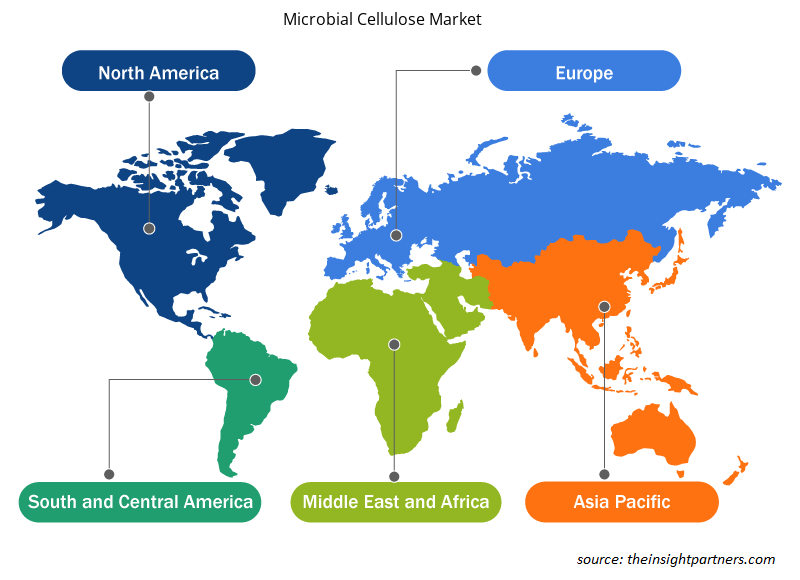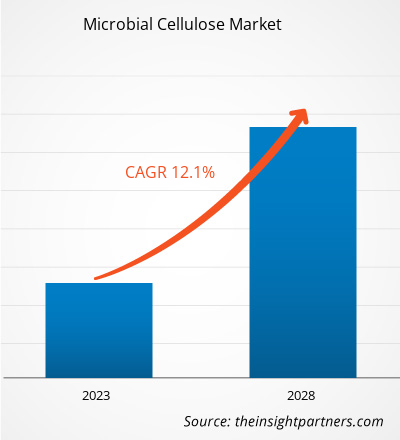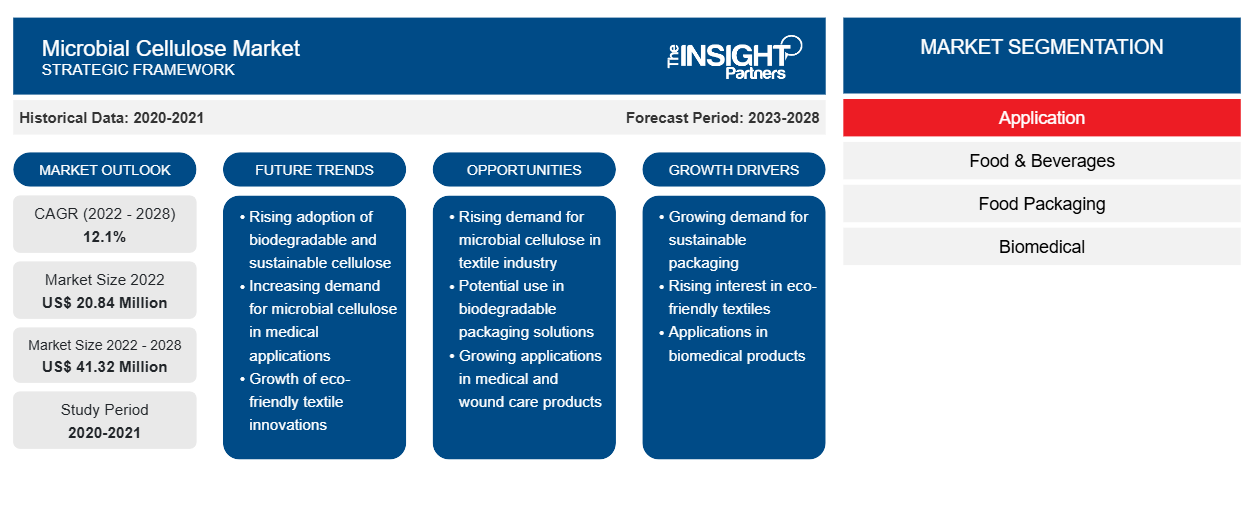[Forschungsbericht] Der Markt für mikrobielle Zellulose soll von 20,84 Millionen US-Dollar im Jahr 2022 auf 41,32 Millionen US-Dollar im Jahr 2028 wachsen; von 2022 bis 2028 wird eine durchschnittliche jährliche Wachstumsrate (CAGR) von 12,1 % erwartet.
Mikrobielle Zellulose wird durch Fermentation von Nährmedien hergestellt, die reich an Glucose und Fructose als Hauptkohlenstoffquellen sind. Mikrobielle Zellulose hat eine höhere Zugfestigkeit und Wasserspeicherkapazität und ist biologisch abbaubar, im Gegensatz zu pflanzlicher Zellulose, die schwer biologisch abbaubar ist. Bakterielle Zellulose hat auch einen höheren Polymerisationsgrad als pflanzliche Zellulose, was sie sehr anfällig für Temperaturschwankungen macht, und ist frei von Lignin, Hemizellulose und Pektin. Mikrobielle Zellulose gewinnt als Biomaterial enorm an Bedeutung, da sie eine umweltfreundliche Alternative zu verschiedenen herkömmlichen Kunststoffen wie Polyethylen und Polypropylen darstellt. Sie wird auch in der biomedizinischen Industrie für Wundverbände und medizinische Implantate verwendet. Somit treiben verschiedene Anwendungen von mikrobieller Zellulose das Wachstum des globalen Marktes für mikrobielle Zellulose voran .
Im Jahr 2021 hatte der asiatisch-pazifische Raum den größten Anteil am globalen Markt für mikrobielle Zellulose. In den letzten Jahren war die Region Zeuge eines Anstiegs der Umweltverschmutzung durch die Herstellung und unsachgemäße Entsorgung von Kosmetika und Körperpflegeprodukten aus Rohstoffen, die giftige Substanzen enthalten. Laut einem Bericht von Frontiers Media SA enthalten im asiatisch-pazifischen Raum über 70 % der Kosmetika und Körperpflegeprodukte mindestens eine Mikrobenart als Zutat. Daher steigt die Nachfrage nach mikrobieller Zellulose in der Kosmetikindustrie der Region. Darüber hinaus wächst die Kosmetikindustrie in Südostasien aufgrund der steigenden Kaufkraft der Bevölkerung und der wachsenden Mittelschicht rasant. Daher wird erwartet, dass all diese Faktoren das Wachstum des Marktes für mikrobielle Zellulose im Prognosezeitraum ankurbeln werden.
Passen Sie diesen Bericht Ihren Anforderungen an
Sie erhalten kostenlos individuelle Anpassungen an jedem Bericht, einschließlich Teilen dieses Berichts oder einer Analyse auf Länderebene, eines Excel-Datenpakets sowie tolle Angebote und Rabatte für Start-ups und Universitäten.
-
Holen Sie sich die wichtigsten Markttrends aus diesem Bericht.Dieses KOSTENLOSE Beispiel umfasst eine Datenanalyse von Markttrends bis hin zu Schätzungen und Prognosen.
Auswirkungen der COVID-19-Pandemie auf den Markt für mikrobielle Zellulose
Die Fertigungsindustrie, darunter auch Unternehmen, die mikrobielle Zellulose herstellen, stand nach dem Ausbruch der COVID-19-Pandemie im Jahr 2020 vor beispiellosen Herausforderungen aufgrund von Lieferkettenbeschränkungen infolge landesweiter Lockdowns, Handelsverbote und Reisebeschränkungen. Unterbrechungen der Lieferkette führten zu einem Mangel an Rohstoffen, was die Produktion und den Vertrieb von mikrobieller Zellulose beeinträchtigte und zu höheren Preisen führte. Darüber hinaus führte ein weltweiter Anstieg der medizinischen Abfallproduktion zu Nachhaltigkeitsbedenken bei Verbrauchern, Herstellern und Regierungen verschiedener Länder. Es bestand eine erhebliche Nachfrage nach Einweg-Gesichtsmasken aus nicht biologisch abbaubarem Material. Daher begannen die Hersteller, verschiedene biologisch abbaubare Biopolymere zur Herstellung von Gesichtsmasken zu untersuchen. Dieser Faktor eröffnete den Herstellern von mikrobieller Zellulose neue Möglichkeiten, da mikrobielle Zellulose über wünschenswerte Eigenschaften verfügt, um herkömmliche Materialien, die in Gesichtsmasken verwendet werden, zu ersetzen.
Im Jahr 2021 nahmen viele Volkswirtschaften ihre Produktion wieder auf, nachdem ihre Regierungen Lockerungen der zuvor verhängten Beschränkungen ankündigten, was dem globalen Markt Auftrieb gab. Darüber hinaus durften die Hersteller mit voller Kapazität arbeiten, was ihnen half, die Lücke zwischen Angebot und Nachfrage sowie andere Auswirkungen zu überwinden.
Markteinblicke
Zunehmende Anwendungen in der Kosmetikindustrie kurbeln das Wachstum des Marktes für mikrobielle Zellulose an
Kosmetikhersteller erforschen innovative Ansätze und Materialien, um die Umweltbelastung zu reduzieren. Mikrobielle Zellulose ist ein natürliches und nachhaltiges Material, das von Kosmetikherstellern aufgrund seiner Biokompatibilität, Hauthaftung und Wasserspeichereigenschaften gelobt wird. Mikrobielle Zellulose wird hauptsächlich zur Herstellung von Tuchmasken für die Hautpflege verwendet. Diese Masken haben aufgrund ihrer dreidimensionalen Nanostruktur, die aktive hydrophile Inhaltsstoffe wie Anti-Aging-Mittel und Feuchtigkeitsspender absorbiert, hervorragende Feuchtigkeitsspeichereigenschaften. Biozellulose-Gesichtsmasken haben auch starke Hauthaftungseigenschaften, was zu einer besseren Aufnahme oder Durchdringung von Nährstoffen in die Haut beiträgt. Darüber hinaus suchen die Menschen nach Produkten, die ihnen helfen, jugendlich und frisch auszusehen. Sie sind bereit, enorme Summen für Hautpflegeprodukte auszugeben, die ihre Haut gesund aussehen und strahlend machen. Tuchmasken erfreuen sich bei den Verbrauchern enormer Beliebtheit, da sie helfen, feine Linien, Fältchen, Akne und Pigmentierung zu reduzieren, die Haut zu verjüngen und die Feuchtigkeitsversorgung zu verbessern. All diese Faktoren werden voraussichtlich die Nachfrage nach mikrobieller Zellulose in der Kosmetikindustrie im Prognosezeitraum steigern.
Zu den wichtigsten Akteuren auf dem globalen Markt für mikrobielle Zellulose gehören ScobyTec GmbH, BOWIL Biotech SP Zoo, Polybion SL, Bacpolyzyme Biyomuhendislik Ltd, Axcelon Biopolymers Corp, Bioweg UG, Cellulose Lab Inc, Bacterial Cellulose Solutions Inc, Ashland Inc und BIOINSPIRED MATERIALS SL. Die Marktteilnehmer konzentrieren sich darauf, qualitativ hochwertige Produkte anzubieten, um die Kundennachfrage zu erfüllen. Sie konzentrieren sich auch auf Strategien wie Investitionen in Forschungs- und Entwicklungsaktivitäten, Partnerschaften und Expansion.
Regionale Einblicke in den Markt für mikrobielle Zellulose
Die regionalen Trends und Faktoren, die den Markt für mikrobielle Zellulose im Prognosezeitraum beeinflussen, wurden von den Analysten von Insight Partners ausführlich erläutert. In diesem Abschnitt werden auch die Marktsegmente und die Geografie für mikrobielle Zellulose in Nordamerika, Europa, im asiatisch-pazifischen Raum, im Nahen Osten und Afrika sowie in Süd- und Mittelamerika erörtert.

- Erhalten Sie regionale Daten zum Markt für mikrobielle Zellulose
Umfang des Marktberichts über mikrobielle Zellulose
| Berichtsattribut | Details |
|---|---|
| Marktgröße im Jahr 2022 | 20,84 Millionen US-Dollar |
| Marktgröße bis 2028 | 41,32 Millionen US-Dollar |
| Globale CAGR (2022 - 2028) | 12,1 % |
| Historische Daten | 2020-2021 |
| Prognosezeitraum | 2023–2028 |
| Abgedeckte Segmente |
Nach Anwendung
|
| Abgedeckte Regionen und Länder |
Nordamerika
|
| Marktführer und wichtige Unternehmensprofile |
|
Dichte der Marktteilnehmer für mikrobielle Zellulose: Verständnis ihrer Auswirkungen auf die Geschäftsdynamik
Der Markt für mikrobielle Zellulose wächst rasant, angetrieben durch die steigende Nachfrage der Endverbraucher aufgrund von Faktoren wie sich entwickelnden Verbraucherpräferenzen, technologischen Fortschritten und einem größeren Bewusstsein für die Vorteile des Produkts. Mit steigender Nachfrage erweitern Unternehmen ihr Angebot, entwickeln Innovationen, um die Bedürfnisse der Verbraucher zu erfüllen, und nutzen neue Trends, was das Marktwachstum weiter ankurbelt.
Die Marktteilnehmerdichte bezieht sich auf die Verteilung von Firmen oder Unternehmen, die in einem bestimmten Markt oder einer bestimmten Branche tätig sind. Sie gibt an, wie viele Wettbewerber (Marktteilnehmer) in einem bestimmten Marktraum im Verhältnis zu seiner Größe oder seinem gesamten Marktwert präsent sind.
Die wichtigsten auf dem Markt für mikrobielle Zellulose tätigen Unternehmen sind:
- ScobyTec GmbH
- BOWIL Biotech SP Zoo
- Polybion SL
- Bacpolyzyme Biyomuhendislik Ltd
- Axcelon Biopolymers Corp
Haftungsausschluss : Die oben aufgeführten Unternehmen sind nicht in einer bestimmten Reihenfolge aufgeführt.

- Überblick über die wichtigsten Akteure auf dem Markt für mikrobielle Zellulose
Schlüsselentwicklung
Im Februar 2023 unterzeichneten Bioweg, ein deutsches Startup, das sich mit der Herstellung mikrobieller Zellulose beschäftigt, und Ginkgo Bioworks, ein Unternehmen, das Zellprogrammierungs- und Biosicherheitsplattformen entwickelt, eine Partnerschaftsvereinbarung, um die Produktion mikrobieller Zellulose zu optimieren und neuartige Zellulosevarianten zu entwickeln, die herkömmliche Kunststoffe ersetzen können.
Bericht-Spotlights
- Fortschrittliche Branchentrends auf dem Markt für mikrobielle Zellulose helfen den Akteuren bei der Entwicklung wirksamer langfristiger Strategien
- Von Industrie- und Entwicklungsländern übernommene Strategien für Unternehmenswachstum
- Quantitative Analyse des mikrobiellen Zellulosemarktes von 2020 bis 2028
- Schätzung der weltweiten Nachfrage nach mikrobieller Zellulose
- PEST-Analyse zur Veranschaulichung der politischen, wirtschaftlichen, sozialen und technologischen Faktoren, die das globale Wachstum des Marktes für mikrobielle Zellulose beeinflussen.
- Aktuelle Entwicklungen zum Verständnis des wettbewerbsorientierten Marktszenarios
- Markttrends und -aussichten sowie Faktoren, die das Wachstum des Marktes für mikrobielle Zellulose vorantreiben und bremsen
- Unterstützung im Entscheidungsprozess durch Aufzeigen von Marktstrategien, die das kommerzielle Interesse untermauern und zum Marktwachstum führen
- Marktgröße für mikrobielle Zellulose an verschiedenen Knotenpunkten
- Detaillierte Übersicht und Segmentierung des Marktes sowie der Dynamik der mikrobiellen Zelluloseindustrie
- Größe des mikrobiellen Zellulosemarktes in verschiedenen Regionen mit vielversprechenden Wachstumschancen
- Historische Analyse (2 Jahre), Basisjahr, Prognose (7 Jahre) mit CAGR
- PEST- und SWOT-Analyse
- Marktgröße Wert/Volumen – Global, Regional, Land
- Branchen- und Wettbewerbslandschaft
- Excel-Datensatz
Aktuelle Berichte
Verwandte Berichte
Erfahrungsberichte
Grund zum Kauf
- Fundierte Entscheidungsfindung
- Marktdynamik verstehen
- Wettbewerbsanalyse
- Kundeneinblicke
- Marktprognosen
- Risikominimierung
- Strategische Planung
- Investitionsbegründung
- Identifizierung neuer Märkte
- Verbesserung von Marketingstrategien
- Steigerung der Betriebseffizienz
- Anpassung an regulatorische Trends























 Kostenlose Probe anfordern für - Markt für mikrobielle Zellulose
Kostenlose Probe anfordern für - Markt für mikrobielle Zellulose